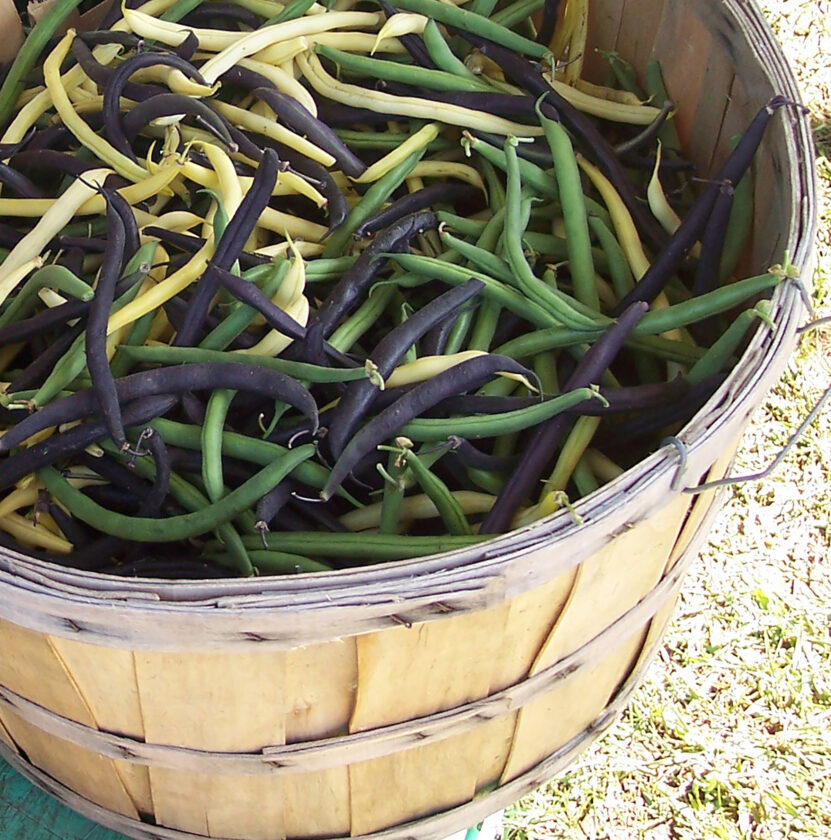Fresh summer beans

Bushel of beans (Provided photo — Yvona Fast)
Summers’ end marks an abundant harvest. The farmers’ market and farm stands are loaded with seasonal veggies — corn, tomatoes, cucumbers, peppers, zucchini … and beans.
I was surprised to learn from local grower Jim Tucker that some people aren’t aware that not all fresh beans are green. The supermarket has trained us well, with canned and frozen ‘green’ beans cut into 2-inch lengths.
Fresh beans do not compare to their soggy, tasteless canned version. They have great flavor and a completely different texture when eaten raw or just slightly cooked, with a bit of crunch.
Fresh beans are a popular summer crop among home gardeners. Look for them at farmers’ markets and roadside stands. There’s much variety in color, shape and size!
Bush beans grow on bushes about 2 feet in height. They produce a crop quickly and ripen all at the same time, allowing for mechanical harvesting, so they’re a popular farm crop. They can be green, yellow or purple. They can be up to 10 inches in length — but younger is better, so stop at 5 inches if you grow your own.
Pole beans (think of Jack and the Beanstalk) grow on tall vines. They need to climb and ripen gradually. Pole beans are grown in home gardens and are sometimes available at farmers’ markets. Last week, my friend Paul gave me some Kwintus beans. Mom loved Scarlet runner beans because of their beautiful red blossoms in June and July. Romano beans are another variety that’s popular in Italy.
Most pole beans are flat, broad, sweet, velvety, stringless, tender and meatier than their bush-bean counterparts. Swinging and twirling on the vine, they look gorgeous — and their flavor is incomparable to anything you can get at the supermarket. These beans need a trellis to climb and grow long beans. They ripen slowly over a long period of time rather than all at once, so they’re great for home gardeners.
Regardless of shape, size or color, all beans belong to the same species and therefore will readily cross with one another when conditions are right. If they are left on the vine for too long, the beans inside the pods start to develop and the pods become tough and stringy.
Beans are a good source of vegetable protein, fiber, antioxidants, vitamins A, C and K, folic acid, potassium, iron and magnesium. One cup of fresh beans contains about 40 calories.
Beans are native to the Western Hemisphere. Along with corn and squash, they were the staples of the Native American diet and were associated with religious rituals. Native Americans dried beans for winter storage, and often ground them into flour.
Sixteenth-century Spanish explorers returning from their travels in the New World brought beans to Europe. Today, they’re a popular vegetable on both sides of the Atlantic.
Some folks like to eat beans raw, but most find raw beans too tough. Blanching or steaming them briefly before adding to salads softens them a bit. Pole beans tend to be larger and tougher than bush beans, so they need longer cooking.
At the farmers’ market, choose beans that are slender and straight-sided, firm and velvety to the touch, vibrant in color, free from blemishes or brown spots and snap when broken to reveal a moist center. Beans that are soft and limp are not fresh; those with obvious bumps are overly mature and tough.
To prepare, rinse to remove sand and grit, snap off ends and cut into bite-sized pieces. There are many ways to cook this versatile vegetable; they can be steamed, boiled, sauteed, stir-fried, microwaved or roasted. Many Americans like them crunchy, while most Italians prefer them soft — but not too soft. Cooking them just past the crunch point makes them slightly sweeter and intensifies their delicate flavor. Italians serve them blanched and drained, still hot from the colander, anointed with the best extra virgin olive oil and a little sea salt. If you like, season them with fresh herbs, garlic or tomatoes. Served this way, beans are a revelation to your taste buds. But take care not to overcook, or their color will fade and their texture will become mushy.
You can add beans to a stir-fry, raw or lightly steamed to salads or simmer lightly to serve as a side dish. Add them to soups, frittatas, casseroles and skillet dishes. Roasting intensifies their flavor, and they may become your new favorite seasonal snack! Serve raw or lightly cooked as a snack or appetizer with your favorite creamy dip.
No matter how you prepare them, make sure they’re fresh! Like corn, peas and tomatoes, beans are best harvested early and eaten right after they’re picked. The pods should not bulge or have brown marks. If they’re old, they’ll be rubbery rather than crunchy. That is why “fresh” supermarket green beans, which have been shipped across continents to arrive in the produce aisle travel-weary, shell-shocked and lifeless, are tough and need longer cooking. They’ve also lost many of their valuable nutrients in transport.
To summarize, the keys to delicious fresh beans are youth, freshness and cooking them to just the right tenderness. Their grassy, buttery flavor will melt on your tongue with the glorious essence of summer, even as we enter the first weeks of autumn.
With Labor Day just around the corner, fresh bean salads are a popular dish to bring to summer picnics and potlucks. Salade Nicoise is a classic French dish that combines steamed green beans with potatoes and tuna. As you celebrate the end of summer and commemorate the role of labor unions in our democracy, add fresh, lightly-cooked beans to potato, pasta, grain and lettuce salads.
–
Greek Style Fresh Bean Salad
–
Ingredients:
–
1 pound fresh beans (mixed colors and shapes) — this is about 5 or 6 cups
2 medium cloves garlic
1 teaspoon salt
1/2 cup balsamic vinegar or apple cider vinegar
2 Tablespoons maple syrup
2 to 3 Tablespoons extra virgin olive oil
1/4 teaspoon ground black pepper
2 sweet onions or a bunch of scallions
2 sweet bell peppers (1 orange, 1 red)
2 tomatoes
1 cup olives
1 cup crumbled Feta cheese
Optional: 1 or 2 cups cooked black beans or cooked kidney beans
–
Directions:
–
Rinse beans. Remove stem ends.
If you like them raw, just cut them into 2-inch lengths. Or blanch or steam the fresh beans. To steam, place beans in steamer basket; fill pot with water and one teaspoon salt. Cover, and cook about 5 minutes until crisp-tender or to your desired tenderness.
While beans cook, fill a medium bowl with ice water. Remove steamer basket and plunge beans into ice water to stop the cooking process. Set aside until chilled, then drain.
While beans cook, crush garlic with a garlic press, mortar and pestle or microplane. In bowl, combine garlic, salt, cider vinegar, olive oil and black pepper. Stir with a fork.
Stir beans into the dressing, and toss.
Peel onion, slice thin and stir in. Wash peppers, remove seeds, slice and stir in. Slice olives and add. Add cooked beans, if using.
This salad is best made early in the day to let flavors blend. If you do this and leave it in the fridge, add the tomatoes and feta just 10 to 15 minutes before serving (they should not be chilled).
–
Fresh Bean and Potato Salad for Two
–
Ingredients:
–
6 small new potatoes (about 1 cup, diced)
1 teaspoon salt
2 cups beans (different varieties and colors if possible)
1/2 cup diced sweet onion or sliced chives or scallions
1/2 cup diced sweet pepper, red, yellow or both
1/4 cup minced fresh parsley, dill or other fresh herbs of your choice
1 or 2 Tablespoons mayonnaise
1 or 2 Tablespoons plain yogurt or sour cream
–
Directions:
–
Scrub and dice potatoes. Cook in salted water until almost tender, about 20 minutes.
Snap off ends of beans and cut into 1 or 2-inch lengths. Add to the pot with potatoes during the last 5 minutes of cooking. Drain and set aside to cool.
Chop and dice onion, pepper and herbs. Set aside.
When potatoes and beans are cool, place in a salad bowl. Fold in mayonnaise, yogurt, onions, peppers and herbs. Taste to adjust seasonings; add salt and pepper to taste.
Serves 2 or 3.
–
Mom’s Buttery Beans
–
Ingredients:
–
1 pound of beans
1 Tablespoon butter
1 Tablespoon breadcrumbs (plain or Italian flavored)
Salt and pepper (1/2 to 1 teaspoon salt, depending on your taste and a sprinkling of black pepper if you wish)
Optional: onion, garlic and/or fresh thyme
–
Directions:
–
Wash beans; remove stem ends; cut into desired lengths. Steam beans to desired tenderness.
While beans cook, melt butter in a skillet or shallow pot large enough to hold beans. Add the breadcrumbs and stir over medium-low heat until nicely golden, 1 or 2 minutes.
Toss cooked, drained beans into the breadcrumbs and stir to coat. Season with salt and pepper. Serve right away. Serves 4.
Note: If using onion or garlic, cook onion or garlic 2 to 5 minutes in the butter before adding bread crumbs. Add fresh chopped thyme, if using, right before you add the breadcrumbs.
— — —
Author of the award-winning cookbook Garden Gourmet: Fresh & Fabulous Meals from your Garden, CSA or Farmers’ Market, Yvona Fast lives in Lake Clear and has two passions: writing and cooking. She can be found at www.yvonafast.com and reached at yvonawrite@yahoo.com or on Twitter: @yvonawrites.




